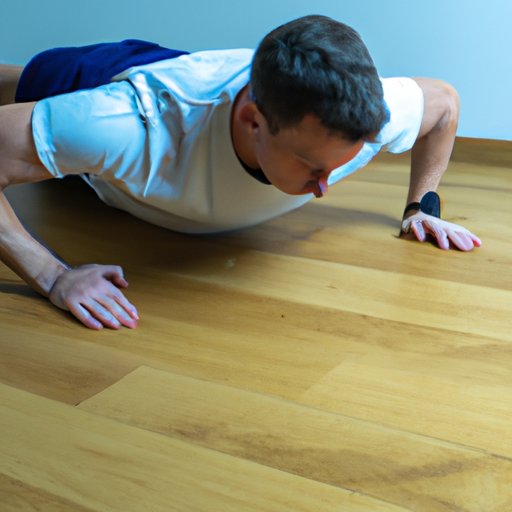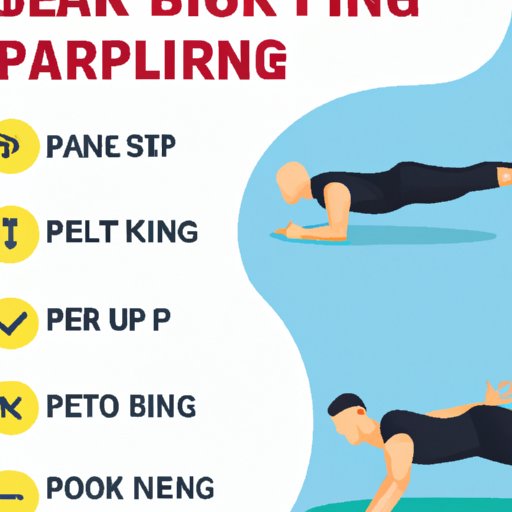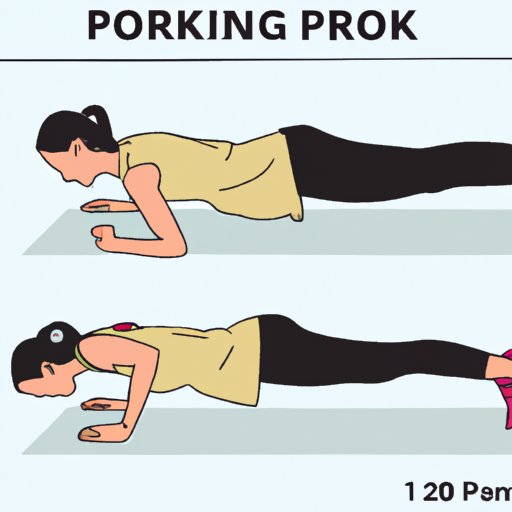Introduction
Plank exercises have become one of the most popular forms of exercise for people looking to build strength and improve their overall fitness level. But what do planks work out? This comprehensive guide will provide an overview of plank exercises, explain the basics of proper planking technique, and offer a comprehensive guide to incorporating plank workouts into your fitness routine.
Overview of Plank Exercises
Plank exercises are a type of bodyweight exercise that involve supporting your body in a prone position, either on your hands or elbows. The goal is to keep your spine in a straight line while engaging your core muscles and maintaining good form throughout the exercise. Planks can be done in many different ways, targeting various muscle groups, and they can be used as part of a complete exercise program.
Benefits of Plank Exercises
Plank exercises offer numerous benefits, both physical and mental. Physically, planks help you strengthen your core muscles, including your abdominals, obliques, and lower back. This increased core strength can help improve your posture and balance, reduce back pain, and make everyday activities like walking, running, and lifting easier. Plank exercises also help you burn fat and calories, tone your muscles, and boost your metabolism.
Mentally, planks can help reduce stress and anxiety. Studies have shown that regular plank exercises can increase focus and concentration, and improve cognitive performance. They can also help with relaxation, as the deep breathing required for proper planks technique helps to reduce stress hormones and clear the mind.

The Basics of Proper Planking Technique
The key to getting the most out of plank exercises is to practice proper planking technique. Here are some tips to help you find the right form and perform each exercise correctly:
Finding the Right Form
To ensure you’re performing plank exercises correctly, it’s important to start by finding the right form. Begin by lying on your stomach with your arms bent at the elbows and your feet together. Then, press your palms into the floor and lift your entire body off the ground, so that you’re resting on your forearms and toes. Make sure your back is straight and your core muscles are engaged.
Alignment and Balance
Once you’ve found the right form, it’s important to maintain proper alignment and balance throughout the exercise. Keep your head in line with your spine, and your shoulders directly above your elbows. Make sure your hips are in line with your shoulders, and your feet are together. If necessary, adjust your stance until you’ve achieved the proper alignment.
Breathing
Deep breathing is essential for proper planking technique. Inhale deeply through your nose and exhale through your mouth, focusing on keeping your breath steady and controlled. This will help you stay focused and maintain good form throughout the exercise.
A Comprehensive Guide to Plank Workouts
Now that you know the basics of proper planking technique, it’s time to create a comprehensive guide to plank workouts. Here’s a look at the different types of plank exercises and how to create a plank workout routine that’s tailored to your needs.
Different Types of Plank Exercises
There are many different types of plank exercises that you can incorporate into your workout routine. These include traditional planks, side planks, reverse planks, mountain climbers, and more. Each exercise targets different muscle groups, so it’s important to choose exercises that will help you reach your fitness goals.
Creating a Plank Workout Routine
When creating a plank workout routine, it’s important to start with basic exercises and gradually increase the intensity as you become more comfortable with the movements. Aim for three to five sets of each exercise, and focus on proper form and breathing throughout the workout. You can also add variations of each exercise to target specific muscle groups and make the workout more challenging.
How to Incorporate Planks into Your Fitness Routine
Now that you know the basics of plank exercises, it’s time to learn how to incorporate them into your fitness routine. Here are some tips to help you get started:
Scheduling Plank Workouts
It’s important to schedule your plank workouts so that you can stick to them. Start by setting aside a few days each week to dedicate to plank exercises. Aim for 20-30 minutes of planks per session, and adjust your routine as needed. For best results, try to fit in at least two plank workouts per week.
Adapting Plank Exercises for Different Fitness Levels
Plank exercises can be adapted for any fitness level, from beginner to advanced. If you’re just starting out, focus on simple exercises and gradually increase the difficulty as you become more comfortable with the movements. For advanced exercisers, challenge yourself by adding variations and increasing the intensity of each exercise.

Plank Variations to Target Specific Muscles
Once you’ve mastered the basics of plank exercises, you can start to incorporate variations to target specific muscle groups. Here are some examples of plank variations you can use to strengthen your core, upper body, and lower body:
Core Strengthening Planks
To strengthen your core muscles, try adding variations like side planks and reverse planks to your routine. These exercises will help you engage your abdominal and oblique muscles, and they can also help improve your balance and posture.
Upper Body Plank Variations
For an added upper body challenge, try adding push-up planks and arm variations to your routine. These exercises will help you build strength in your chest, arms, and shoulders, and they can also help improve your overall stability.
Lower Body Plank Variations
For a lower body challenge, try adding planks with leg lifts and mountain climbers to your routine. These exercises will help you engage your glutes, quads, and hamstrings, and they can also help improve your agility and coordination.

Top Tips for Mastering Plank Exercises
Once you’ve mastered the basics of plank exercises, it’s time to learn how to master them. Here are some top tips to help you get the most out of your planks:
Maintaining Proper Form
It’s important to focus on maintaining proper form throughout each exercise. Make sure your back is straight, your core is engaged, and your breath is steady and controlled. If you start to lose form, take a break and reset before continuing.
Increasing Intensity
As you become more comfortable with plank exercises, you can increase the intensity by adding variations and increasing the duration of each exercise. Aim for 15-30 seconds per exercise, and gradually increase the time as you become stronger.
Avoiding Common Mistakes
It’s important to avoid common mistakes when performing plank exercises, such as arching your back or letting your hips sag. If you feel any pain or discomfort, stop immediately and adjust your form as needed.
Conclusion
Plank exercises offer numerous benefits, both physically and mentally. They help you strengthen your core muscles, improve your posture and balance, and burn fat and calories. When done properly, planks can be a great addition to any fitness routine. With the right form, alignment, and breathing, you can master the basics of plank exercises and reap the rewards.
Summary of Benefits
Plank exercises offer a variety of physical and mental benefits, including increased core strength, improved posture and balance, reduced back pain, increased metabolism, and improved focus and concentration. They can also help reduce stress and anxiety.
Final Thoughts on Mastering Plank Exercises
Mastering plank exercises requires practice and dedication. Start by learning the basics of proper planking technique and gradually increase the intensity as you become more comfortable with the movements. With the right form, alignment, and breathing, you can reap the benefits of plank exercises and achieve your fitness goals.
(Note: Is this article not meeting your expectations? Do you have knowledge or insights to share? Unlock new opportunities and expand your reach by joining our authors team. Click Registration to join us and share your expertise with our readers.)
